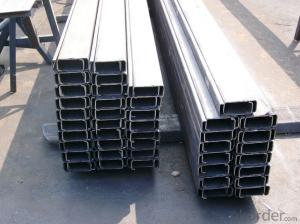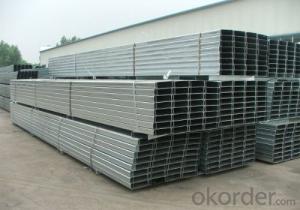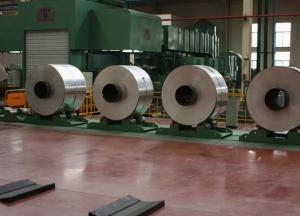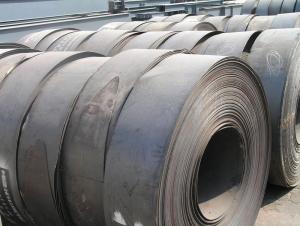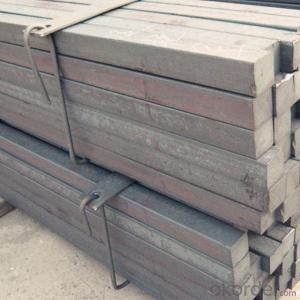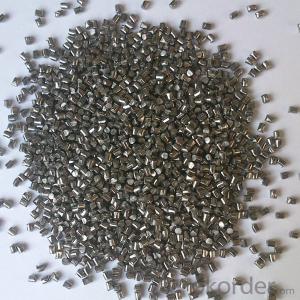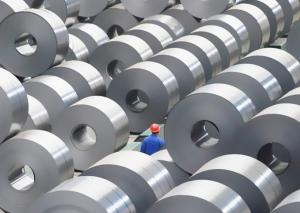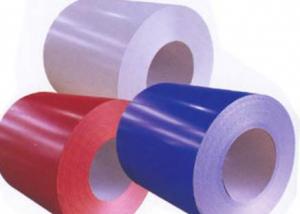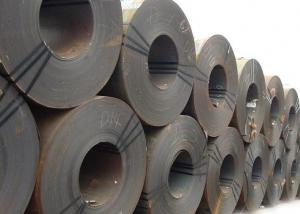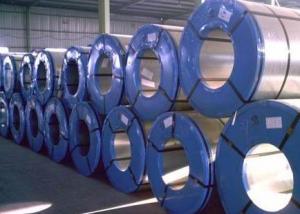Cold Rolled C Channel with High Quality C100/C120
- Loading Port:
- China main port
- Payment Terms:
- TT OR LC
- Min Order Qty:
- 100 m.t
- Supply Capability:
- 15000 m.t/month
OKorder Service Pledge
OKorder Financial Service
You Might Also Like
Item specifice
Specifications of Cold Rolled C Channel with High Quality C100/C120:
1.Our Cold Rolled C Channel with High Quality C100/C120 has lots of advantages, just as followings:
a) At reasonable price and good quality.
b) To be convenient in construction and to save much time and labor.
c) The length of Cold Rolled C Channel can be manufactured according to customer’s requirements.
d) The Cold Rolled C Channel has strong mechanical strength.
e). The Cold Rolled C Channel possesses various kind of fittings, through which it is suitbal for many combinations.
The detailed sections of Cold Rolled C Channel with High Quality C100/C120 as per GB standard:
| Model | Section size | |||
| h(mm) | b(mm) | a(mm) | s(mm) | |
| C100 | 100 | 40 | 20 | 1.6-3.2 |
| C120 | 120 | 40 | 20 | 1.6-3.2 |
| C120 | 120 | 50 | 20 | 1.6-3.2 |
| C120 | 120 | 60 | 20 | 1.6-3.2 |
The mechanical property of MS Cold Rolled C Channel with High Quality C100/C120 according to Q235B:
Alloy No | Grade | Yielding Strength Point(Mpa) | |||
Thickness(mm) | |||||
≦16 | >16-40 | >40-60 | >60-100 | ||
≧ | |||||
Q235 | B | 235 | 225 | 215 | 205 |
Alloy No | Grade | Tensile Strength(Mpa) | Elongation After Fracture(%) | |||
Thickness(mm) | ||||||
≦16 | >16-40 | >40-60 | >60-100 | |||
≧ | ||||||
G235 | B | 375-500 | 26 | 25 | 24 | 23 |
FAQ:
Q1: Why buy Materials & Equipment from OKorder.com?
A1: All products offered by OKorder.com are carefully selected from China's most reliable manufacturing enterprises. Through its ISO certifications, OKorder.com adheres to the highest standards and a commitment to supply chain safety and customer satisfaction.
Q2: How do we guarantee the quality of our products?
A2: We have established an advanced quality management system which conducts strict quality tests at every step, from raw materials to the final product. At the same time, we provide extensive follow-up service assurances as required.
Q3: How soon can we receive the product after purchase?
A3: Within three days of placing an order, we will arrange production. The shipping date is dependent upon the quatity, how many sizes you want and the plan of production, but is typically 1 month to 2 months from the beginning of production.
Images of Cold Rolled C Channel with High Quality C100/C120:
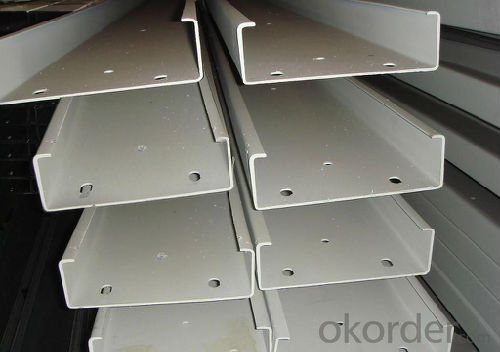
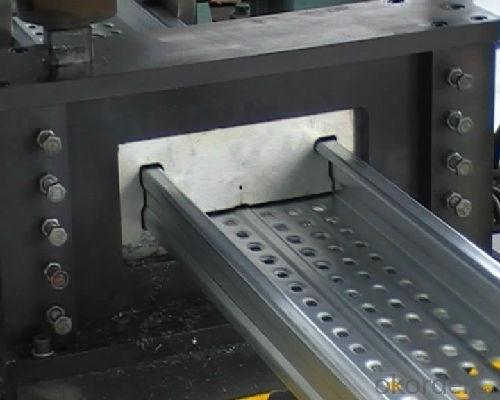
*If you would like to get our price, please inform us the size, standard/material and quantity. Thank you very much for your attention.
- Q:What are the different types of steel tanks and containers available?
- There are various types of steel tanks and containers available, including welded steel tanks, bolted steel tanks, stainless steel tanks, and corrugated steel containers. Each type has its own unique features and applications, ranging from water storage tanks to chemical storage containers and industrial bulk storage tanks.
- Q:How are steel sheets used in the manufacturing of industrial machinery?
- Steel sheets are used in the manufacturing of industrial machinery because of their high strength, durability, and versatility. They can be fabricated into various components such as frames, panels, and casings, providing structural support and protection. Steel sheets are also used for forming complex shapes through processes like bending, cutting, and welding. Additionally, they offer resistance to heat, corrosion, and wear, making them suitable for harsh industrial environments.
- Q:What is the process of steel galvanization?
- The process of steel galvanization involves immersing the steel in a bath of molten zinc or applying a zinc coating to the steel through a hot-dip or electroplating method. This forms a protective layer of zinc on the surface of the steel, preventing rust and corrosion and increasing its durability.
- Q:How is steel used in the production of kitchen utensils and cookware?
- Steel is commonly used in the production of kitchen utensils and cookware due to its durability, heat conductivity, and resistance to corrosion. It is often used as the primary material for pots, pans, knives, and other kitchen tools, ensuring long-lasting performance and even heat distribution during cooking.
- Q:How is steel wire galvanized?
- Steel wire is galvanized by immersing it in a bath of molten zinc or by electroplating it with a layer of zinc. This process helps to protect the steel wire from corrosion and extends its lifespan.
- Q:How do steel products contribute to the water and wastewater treatment sector?
- Steel products play a crucial role in the water and wastewater treatment sector due to their durability, strength, and corrosion resistance. They are used extensively in the construction of various infrastructure and equipment, such as pipes, tanks, pumps, and valves, which are essential for transporting, storing, and treating water and wastewater. These steel products ensure the reliability and longevity of the systems, minimizing leaks, failures, and maintenance requirements. Additionally, steel's recyclability and sustainability make it an environmentally friendly choice for the water and wastewater treatment industry.
- Q:What are the different types of steel coils and their uses?
- There are several types of steel coils, including hot-rolled, cold-rolled, galvanized, and stainless steel coils. Hot-rolled coils are used for applications requiring high strength and durability, such as automotive parts and construction materials. Cold-rolled coils are used for precision applications where a smooth and polished surface is required, such as in appliances and metal furniture. Galvanized coils are coated with a layer of zinc to prevent corrosion, making them suitable for outdoor structures and roofing. Stainless steel coils are highly resistant to corrosion and are used in various industries, including food processing, chemical processing, and medical equipment manufacturing.
- Q:What are the different types of steel bolts and their uses?
- There are various types of steel bolts, each designed for specific applications. Common types include: 1. Hex bolts: These bolts have a hexagonal head and are used in a wide range of applications. They provide a secure fastening and are commonly used in construction, machinery, and automotive industries. 2. Carriage bolts: These bolts have a smooth, rounded head and a square neck beneath it. They are commonly used in wood-to-wood connections, such as in furniture assembly or construction. 3. Eye bolts: These bolts have a looped head, allowing for the attachment of ropes, cables, or chains. They are often used for lifting heavy loads or securing equipment. 4. U-bolts: These bolts have a U-shape and are commonly used to secure pipes or other round objects to a surface. They are often used in plumbing, automotive, or construction applications. 5. Toggle bolts: These bolts have a spring-loaded wing design that allows for easy installation in hollow materials such as drywall. They are often used for hanging lightweight objects on walls. 6. Stud bolts: These bolts have no head and are threaded on both ends. They are commonly used in flange connections, where they provide a firm and secure joint. Each type of steel bolt has its specific uses and applications, and selecting the right one ensures proper fastening and reliability in various industries.
- Q:What are the common uses of steel products in construction?
- Steel products are commonly used in construction for various purposes such as structural support, reinforcement, framing, and fabrication of beams, columns, and trusses. Steel is also used for roofing, cladding, and siding due to its durability, strength, and resistance to fire and weather conditions. Additionally, steel is utilized for the construction of bridges, highways, and other infrastructure projects, as well as for the production of doors, windows, and fixtures.
- Q:How is steel wire rope inspected for fatigue and wear?
- Steel wire rope is inspected for fatigue and wear through visual examination and non-destructive tests. This includes inspecting the rope for signs of corrosion, broken wires, or distorted strands. Additionally, magnetic particle inspection and ultrasonic testing are often used to detect hidden defects and measure the rope's internal condition. Regular inspections and maintenance help ensure the integrity and safety of steel wire ropes.
1. Manufacturer Overview |
|
|---|---|
| Location | |
| Year Established | |
| Annual Output Value | |
| Main Markets | |
| Company Certifications | |
2. Manufacturer Certificates |
|
|---|---|
| a) Certification Name | |
| Range | |
| Reference | |
| Validity Period | |
3. Manufacturer Capability |
|
|---|---|
| a)Trade Capacity | |
| Nearest Port | |
| Export Percentage | |
| No.of Employees in Trade Department | |
| Language Spoken: | |
| b)Factory Information | |
| Factory Size: | |
| No. of Production Lines | |
| Contract Manufacturing | |
| Product Price Range | |
Send your message to us
Cold Rolled C Channel with High Quality C100/C120
- Loading Port:
- China main port
- Payment Terms:
- TT OR LC
- Min Order Qty:
- 100 m.t
- Supply Capability:
- 15000 m.t/month
OKorder Service Pledge
OKorder Financial Service
Similar products
New products
Hot products
Related keywords
